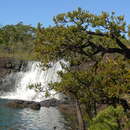en
names in breadcrumbs


Retrophyllum minus, the bois bouchon, is a species of conifer in the family Podocarpaceae. It is endemic to New Caledonia.[1]
It is a sparsely branched small tree with a flared trunk which tapers towards the top and has rough bark.[2] It produces pear-shaped fruits that are dark-red when mature.[2]
The species occurs near rivers and lakes of the Plaine des Lakes in the south of Grande Terre.[2] It is a rheophyte (grows in running water), the only such conifer known.[3]
It is threatened by habitat loss to mining and wildfire.[1]
Retrophyllum minus, the bois bouchon, is a species of conifer in the family Podocarpaceae. It is endemic to New Caledonia.
It is a sparsely branched small tree with a flared trunk which tapers towards the top and has rough bark. It produces pear-shaped fruits that are dark-red when mature.
The species occurs near rivers and lakes of the Plaine des Lakes in the south of Grande Terre. It is a rheophyte (grows in running water), the only such conifer known.
It is threatened by habitat loss to mining and wildfire.